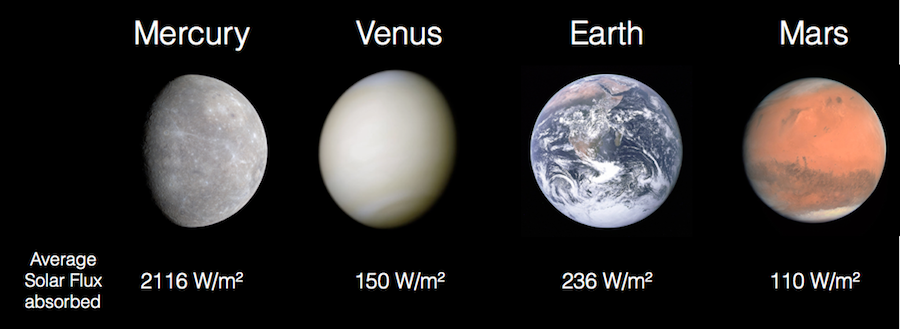Warming App
An oversimplified cartoon model to predict the temperature of a planet

Image: NASA
Congratulations! You've just created a planet.
Brrr! It's cold, all the way out in space. You need to warm your planet up.
So, let's gently place your planet in orbit around the Sun. Let it sit there for a while and soak up those sweet solar photons.

Image: NASA
Ahhh... that's much better. At first the planet's temperature starts shooting up. After warming up for a while, the planet eventually settles into an energy balance, where the incoming solar energy balances the heat that the planet radiates.
Once this balance is reached, your planet's temperature has stabilized. Let's work out what this planetary temperature will be. To do this, we're going to need to make some massively simplifying assumptions.
First, we're going to assume that your planet doesn't have a greenhouse effect. Maybe it doesn't have an atmosphere at all. So the temperature of your planet depends primarily on how far away it is from the Sun, which affects how much sunlight it gets.
Also, we'll assume there are no extra feedbacks at that can change your planets temperature. So we won't worry about things like ice or clouds forming, which would otherwise affect how much energy your planet absorbes. The only mechanism we're considering here is the balance between energy absorbed and heat radiated.
Finally, we're only considering the temperature averaged over the entire planet, and not worrying about the fact that it's colder in the poles, and warmer in the equators (or warmer durring the day, and colder at night).
So let's get started.

Image: NASA
You get to chose the 'Solar Flux' on your planet. This number tells us the average amount of energy absorbed by one square meter of the planet's surface in one second.
To help you get started, here are the values for the four planets closest to the Sun. (These numbers are calculated after taking into account each planet's albedo or reflectivity.)

Select Solar Flux
Drag the slider or use the input box to set the solar flux on your planet.
The Incoming Solar Flux of your planet is {{data.ein}} W/m².
Once the yellow and red pile match, the planet is in equilibrium. The temperature that this simulation settles into is known as the Planetary Equilibrium Temperature, or the blackbody temperature of the planet.
Mathematically, the equilibrium temperature that your planet will end up at is the solution to the equation {{data.ein}} = σ T⁴, where σ is a number known as the Stefan-Boltzmann Constant, and T is the temperature measured in Kelvin. The solution to this equation is T = {{temp}} Kelvin, or {{ktoc(temp)}}° C.
How do the predictions of this simple model compare? You can look up the actual average temperatures for these planets.
You'll find that for the planets with little to no atmosphere, and a weak greenhouse effect, we get remarkably close to the actual planetary temperatures. But for planets with a significant greenhouse effect, we miss the mark. The stronger the greenhouse effect, the more incorrect this calculation will be. The difference between the actual planetary temperature and the predicted equilibrium temperature tells you about the strength of the greenhouse effect.